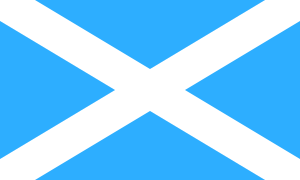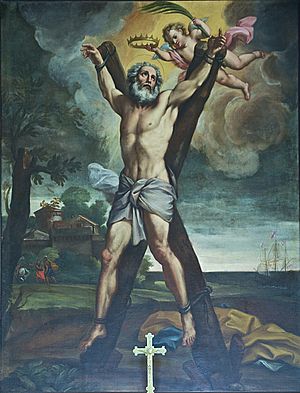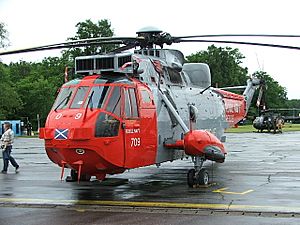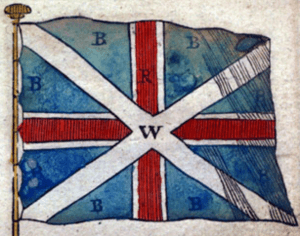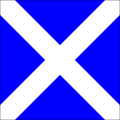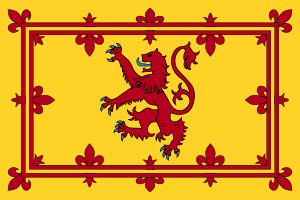Flag of Scotland facts for kids
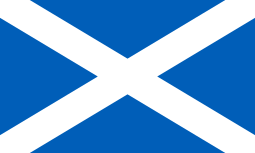 |
|
| Name | St Andrew's Cross The Saltire |
|---|---|
| Use | Civil |
| Proportion | 3:5 |
| Adopted | 1542 (national flag) |
| Design | A blue field with a white saltire that extends to the corners of the flag. In Blazon, Azure, a saltire Argent. |
The flag of Scotland, also known as St Andrew's Cross or the Saltire, is Scotland's national flag. It has a white X-shaped cross on a blue background. This flag is the correct one for everyone in Scotland to fly, including people and businesses. The Scottish Government also flies it on its buildings every day from 8:00 am until sunset, with a few special exceptions.
The first time this flag was shown in a drawing was around 1542, in a book called Register of Scottish Arms by Sir David Lyndsay. It might have been based on an earlier flag from the late 1400s. That flag was supposedly made by Queen Margaret, who was married to King James III.
Contents
Design of the Scottish Flag
The X-shaped cross on the flag is called a 'saltire'. This word comes from an old French word meaning a type of cross. In the language of flags and coats of arms, it's described as "azure, a saltire argent." This means a blue background with a white or silver saltire.
The word "azure" doesn't mean one exact shade of blue. In the past, natural dyes were used to color fabrics. These dyes came from plants and could create many different shades of blue. Because of this, the blue on the Scottish flag has varied over time, from light sky blue to dark navy blue.
When the Scottish flag was combined with the English flag to create the Union Flag in the 1600s, a dark blue was often chosen. This was probably because darker dyes lasted longer, especially for flags used on ships. Over time, this dark blue became common for the Union Flag. Some flag makers then started using this same navy blue for the Scottish flag too.
To make the color consistent, a committee of the Scottish Parliament decided in 2003 that the best shade of blue for the Saltire is Pantone 300. This blue is a bit lighter than the blue on the Union Flag. Now, most Scottish flags use this official color.
The exact size of the flag isn't strictly set, but a common proportion is 5:4 (meaning it's a bit wider than it is tall). However, flag makers might use other sizes like 1:2 or 2:3. The width of the white bars of the saltire is usually about one-third to one-fifth of the flag's total width.
History of the Saltire Flag
A famous story says that the Saltire flag comes from a battle in 832 A.D. King Óengus II led an army of Picts and Scots against the Angles. The night before the battle, Óengus prayed and promised that if he won, he would make Saint Andrew the patron saint of Scotland. Saint Andrew then appeared to him in a dream and promised victory.
On the morning of the battle, white clouds shaped like an X appeared in the sky. Óengus and his army felt very brave because of this sign. Even though they had fewer soldiers, they won the battle. Óengus believed the X-shape represented the cross where Saint Andrew was crucified. So, he kept his promise and made Saint Andrew the patron saint of Scotland. The white saltire on a blue background is said to have become the flag of Scotland because of this legend.
The Saltire was first used as a national symbol on a seal in 1286. But the first time it was clearly shown as a flag was later. A very large flag on a ship called the Great Michael had the "Sanct Androis cors" (Saint Andrew's Cross) on a blue background. By 1542, the white saltire on a blue background was definitely shown as the flag of Scotland. An even older flag, called the "Blue Blanket of the Trades of Edinburgh," also had a white saltire on a blue field.
How the Flag is Used
Use by the Scottish Government

The Scottish Government has decided that the Saltire should fly on all its buildings every day from 8 am until sunset. However, on certain "national days" for the United Kingdom, if a building only has one flagpole, the Saltire is taken down and the Union Flag is flown instead. This is common across the UK.
But there's a special rule for Scotland on Saint Andrew's Day (November 30th). On this day, if a building has only one flagpole, the Saltire stays up. The Union Flag is only flown if there are two or more flagpoles. This rule was made because people felt it was important for Scotland to fly its own national flag on its national day.
Many parts of the Scottish Government use the Saltire in their logos. For example, the "Safer Scotland" logo shows a lighthouse shining light in the shape of a saltire. Other Scottish groups, both private and public, also use the saltire in their designs.
Use by Military Groups
Scottish Army units, like the Scots Guards, use the Saltire in different ways. Their vehicles, like tanks, might have small Saltire stickers on them. In places like Iraq, the Saltire was sometimes flown from antennas on military vehicles. At military funerals for soldiers from these units, the Saltire is often draped over the coffin.
The British Army also used the Saltire in Iraq to help local people recognize Scottish troops. They hoped this would build better relationships. Leaflets were given out to Iraqi civilians showing Scottish soldiers with the Saltire in the background.
When Scotland's infantry regiments joined to form the Royal Regiment of Scotland in 2006, the Saltire was used in their recruitment campaigns. The new logo had the words "Scottish Infantry. Forward As One." next to a picture of the Saltire.
The Saltire also appears on the cap badge of the Royal Regiment of Scotland. It's a silver saltire with a gold lion on top. Other military groups, like some Army Air Corps squadrons and university officer training units, also feature the Saltire in their badges.
The Royal Navy's Fleet Air Arm used to have Saltire stickers on their Westland Sea King helicopters that did search and rescue missions from Glasgow Prestwick Airport.
General Use of the Flag
In Scotland, anyone can fly the Saltire at any time, whether it's an individual, a company, a local council, a hospital, or a school. Many local councils fly the Saltire on their buildings.
In the United Kingdom, car owners can choose to have the Saltire on their vehicle registration plates, along with "SCO" or "Scotland." In 1999, the Royal Mail even put the Flag of Scotland on a postage stamp. In Northern Ireland, some people use the Saltire to show their Ulster-Scots heritage.
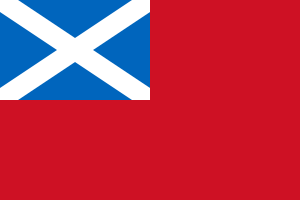
The Saltire is also used on ships. For example, the Scottish Government's patrol vessel Jura flies it. The ferry company Caledonian MacBrayne also flies the Saltire on its ships. However, the Saltire looks a lot like the international signal flag "M" (Mike), which means "My vessel is stopped." To avoid confusion, some Scottish sailors want official recognition for the historic Scottish Red Ensign, which was used by Scottish ships before 1707.
In May 2016, the Saltire was flown on horseback during The Queen's 90th birthday celebration at Windsor, alongside the flags of England, Northern Ireland, and Wales.
The Saltire in the Union Flag
The Saltire is a very important part of the Union Flag. The Union Flag was first created in 1606 when the flags of Scotland and England were combined. This happened three years after James VI, King of Scots, also became King of England and Ireland.
King James announced on April 12, 1606, that all ships from Great Britain should fly a new flag. This flag would combine the red cross of Saint George (England) and the white cross of Saint Andrew (Scotland).
However, many Scottish ship owners were unhappy with the design. They felt that the English cross was placed on top of the Scottish cross, making the Scottish cross look hidden. They complained to King James, saying it would cause problems between the two nations.

Even though the original drawings of the Scottish complaint are lost, there is evidence that a "Scottish variant" of the Union Flag existed. In this version, the Scottish cross appeared on top. While this design was not official, it seems that Scottish ships used it in the 1600s. An old book from 1704 also describes this Scottish Union Flag.
On land, an engraving of Edinburgh Castle from around 1693 shows the Scottish version of the Union Flag flying from the castle's clock tower.
In 1707, just before Scotland and England officially united to form Great Britain, Queen Anne and her advisors looked at different flag designs. The Scottish representatives asked for the version where the Cross of Saint Andrew was on top. But Queen Anne approved the original design, with the Cross of Saint George on top.
In 1801, the Union Flag changed again to include the St Patrick's Cross when Great Britain united with Ireland. Even today, some flag makers still produce the historic Scottish Union Flag, and some people fly it unofficially. However, the 1801 design remains the official flag of the entire United Kingdom.
-
Scottish Union Flag. An unofficial version used in Scotland after the Union of the Crowns.
-
Flag of the United Kingdom, flying alongside the Flag of England.
Flags Similar to the Saltire
Many flags outside the United Kingdom are based on the Scottish saltire. In Canada, the flag of the province of Nova Scotia uses a blue saltire on a white background, combined with the shield from the Scottish royal arms. Nova Scotia means "New Scotland" in Latin, and it was the first place Scotland tried to set up a colony in the Americas.
The Dutch town of Sint-Oedenrode, named after a Scottish princess called Saint Oda, uses a version of the Scottish flag. It has a gold castle on it.
-
Flag of the Scottish Australian Heritage Council, Australia.
-
Regimental flag of the Royal Regiment of Scotland.
-
Flag of Sint-Oedenrode, Netherlands.
Royal Standard of Scotland
The Royal Standard of Scotland is also known as the Lion Rampant of Scotland. This flag was historically used by the Kings of Scots. It is different from Scotland's national flag, the Saltire. The Royal Standard can only be used by a few special government officials who represent the King or Queen in Scotland. It is also flown at royal homes in Scotland when the King or Queen is not there.
Gallery
-
The Saltire, the national flag of Scotland: A white saltire on a blue field.
-
The Flag of the United Kingdom, Flag of Scotland and Flag of Europe at the Scottish Parliament Building.
-
A variety of Saltires at Murrayfield Stadium; the national stadium for Rugby Union in Scotland.
-
The Flag of Scotland and Flag of Canada at the Canmore Highland Games.
-
The Flag of Scotland seating design at Hampden Park Stadium; the national stadium for Football in Scotland.
-
A replica 17th-century Covenanters' flag.
-
A defaced Saltire belonging to the Bass Rock golf club, North Berwick.
-
The defaced Saltire of the Royal Burgh of Selkirk leading the Common Riding.
Images for kids
-
Arms of King James V (r. 1513–1542)
See also
 In Spanish: Bandera de Escocia para niños
In Spanish: Bandera de Escocia para niños


